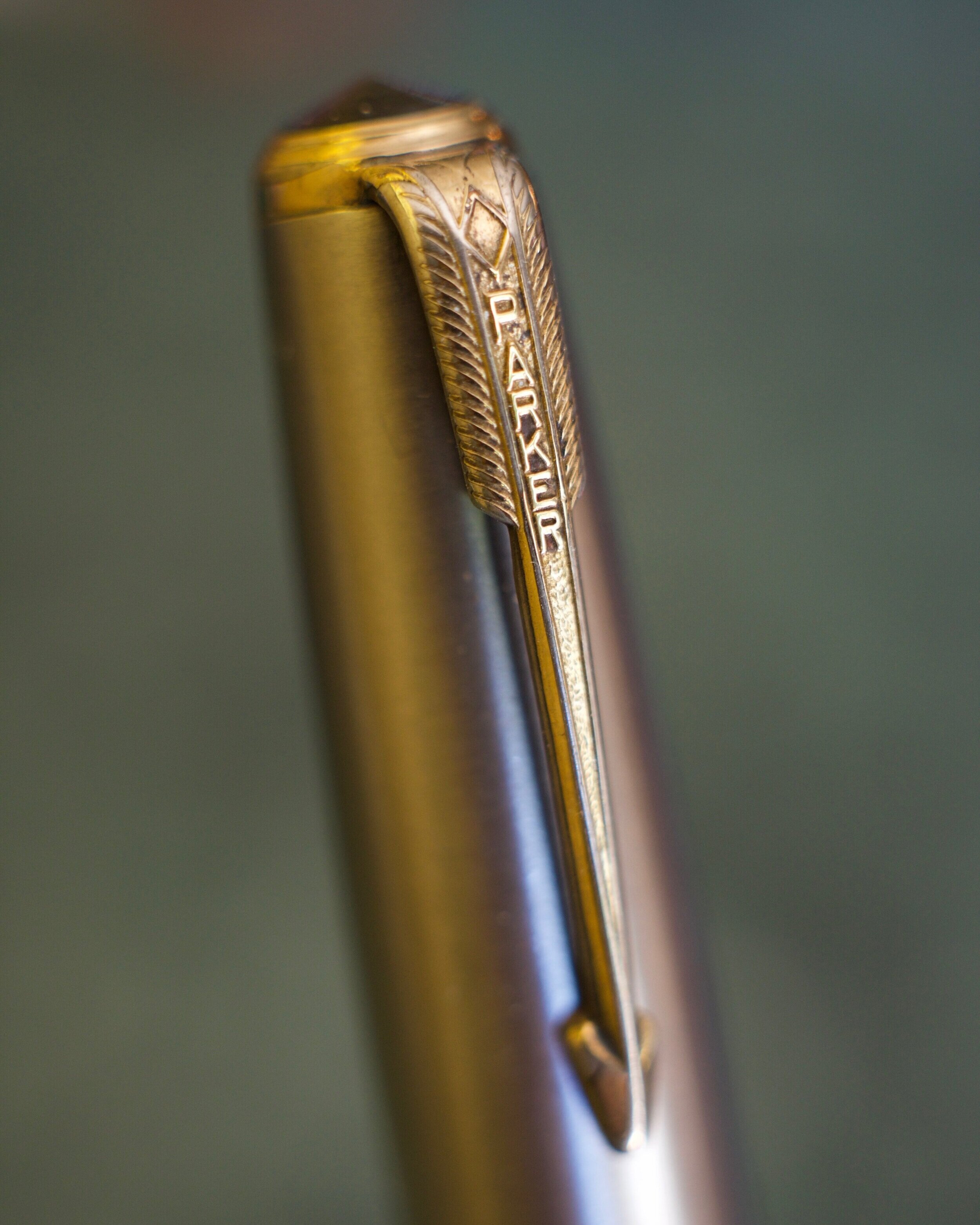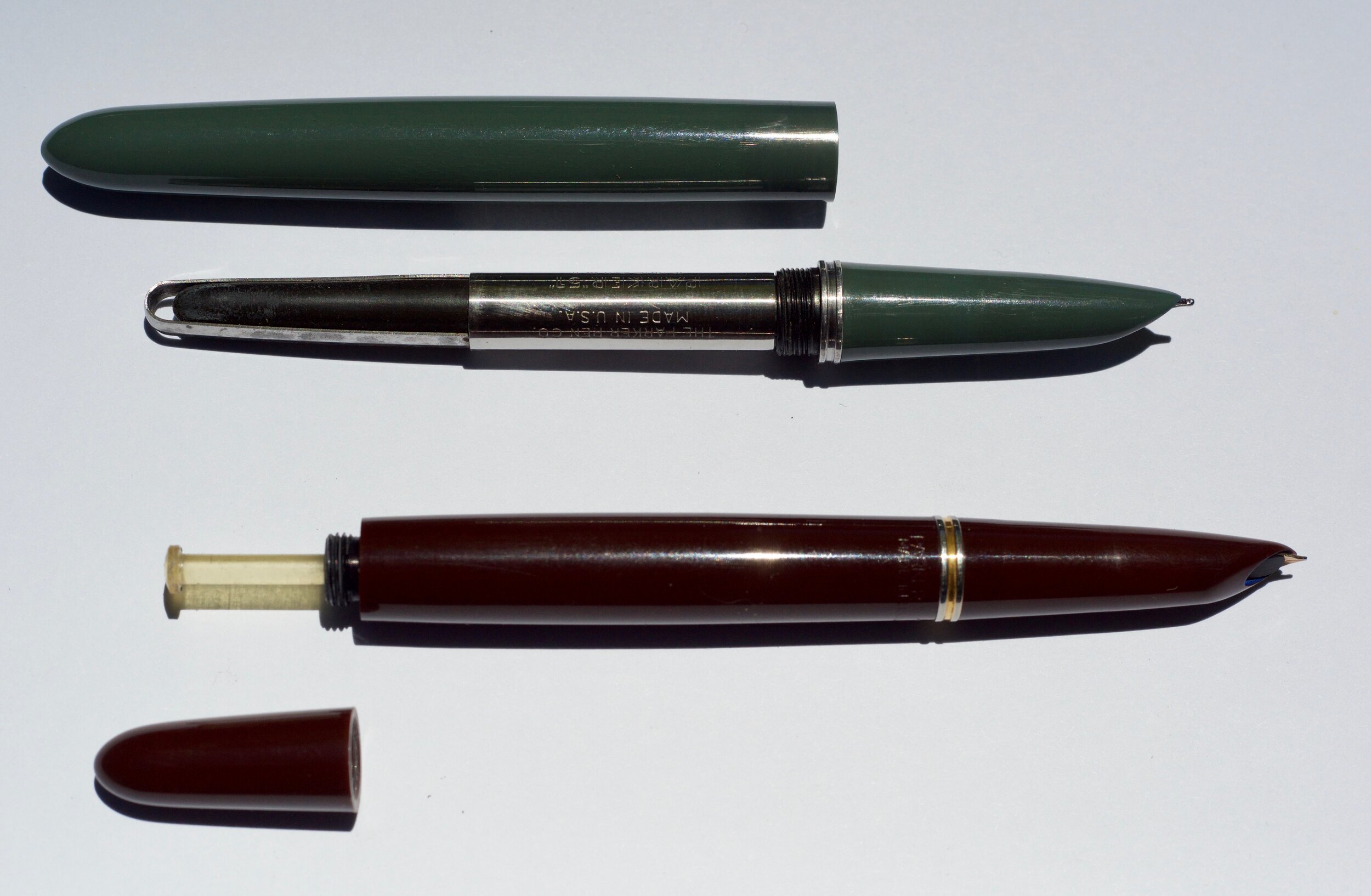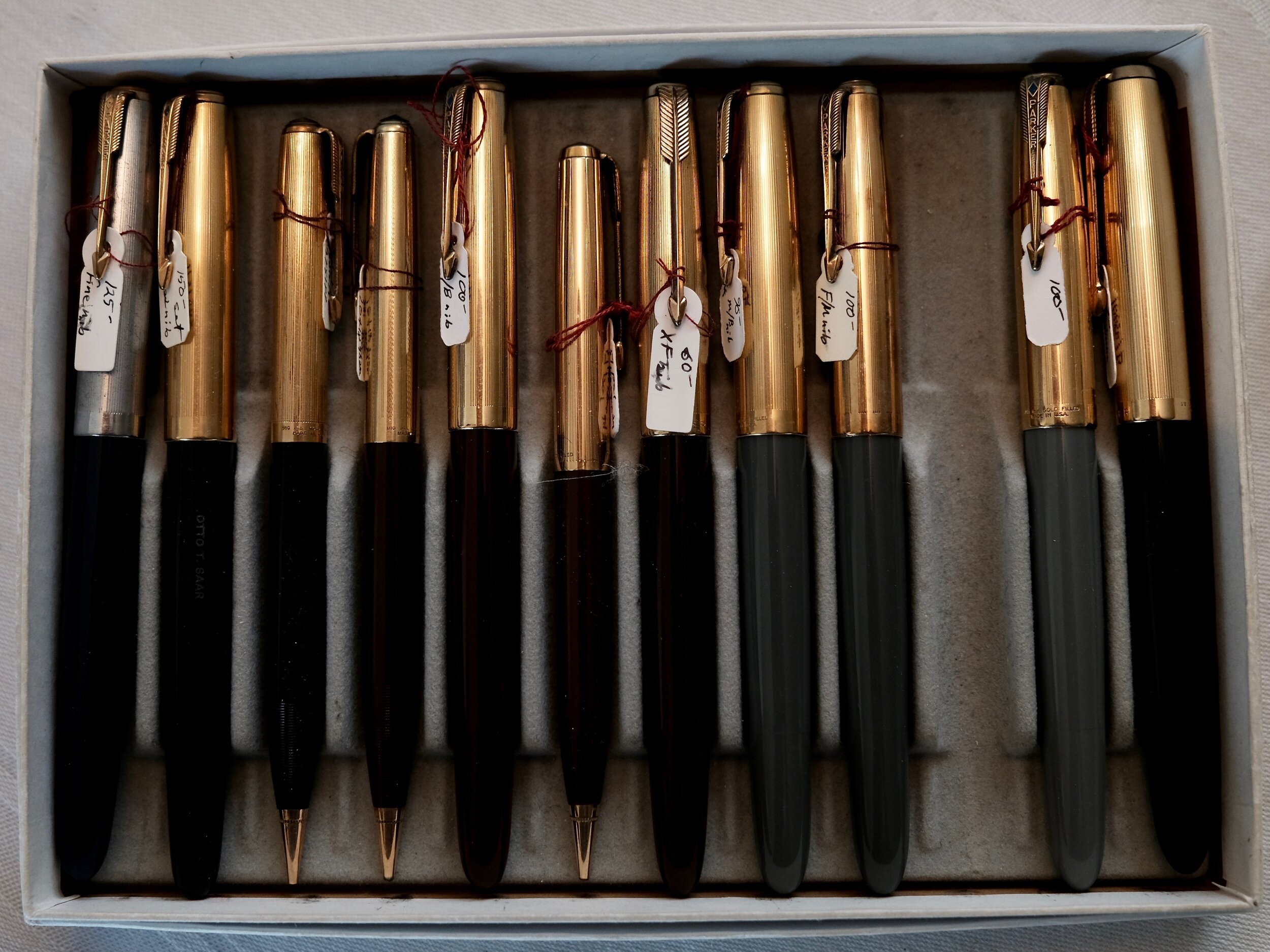The Parker 51 fountain pen
The classic early Parker 51 cap and pocket clip. The clip was not unique to the model 51. It was used across the range of Parker pens. It shows the attention the Parker company paid to the most mundane of objects. Details like this make the 51 a joy to use as well as a delight to the eye.
Words+Photograpy: Mike Blanchard
You might think, “Who cares about pens?” Well, think about it. If you own old cars or collector vehicles, and study history or love fine vintage cameras and watches, or collect antique tools, what are you doing using a junk plastic ballpoint pen? You are going all vintage and then you cheap out on your writing instrument and miss something that was essential to the experience of those who came before us. Put a bit of history in your hand; try a fountain pen.
Let’s take a quick look back at the history of one of man’s most significant inventions: the pen.
Like every kind of tech ever, the very act of writing has gone through a number of evolutions. From fingers to wooden styli to the computer, how we record the present for posterity has changed in ways that the people of the past would never recognize.
For much of recorded history, people used the quill (or its cousin the wooden/bamboo pen). Whether writing on bamboo strips, palm strips, papyrus, velum or paper, the sharpened feather of a largish bird dipped in ink was the way to go.
The metal-nib pen goes back over 1,000 years. Copper-nibbed pens were found at Pompeii. Steel-nib pens came into common use in the early 18th century in England. Of course, the writer had to bring ink along with the pen. These type of pens are still used by artists for pen-and-ink work.
Pens that feature an ink reservoir (fountain pens) are mentioned as far back as the 10th century in Islamic literature. Opinions vary as to when, where, and by whom a workable fountain pen was invented. The earliest fountain pens were filled with eye droppers. So-called "self-filling" pens followed. A U.S. patent for a self-filling pen was granted to one John Jacob parker in 1831 [1832?].
The self-filling reservoir pen meant you could conveniently carry an inked pen with you. At first these pens were horrible leakers and prone to empty their ink onto the user’s clothing or desk. But makers soon got a handle on this unacceptable issue, more or less, and the golden age of the fountain pen dawned around the turn of the 20th Century.
Fountain pens became little design masterpieces, and along with a wallet, watch and pocket knife became an essential part of every man’s personal kit. In fact, for many people they still are. The quality of one’s pen speaks to how serious you are about writing. Companies like Mont Blanc, Parker, Cross, Waterman, Pelikan, Sheaffer, and a host of others offer everything from everyday "user" pens to gold-and-jewel-encrusted works of art.
Clear demonstrator version of the Vacumatic model 51. Note the hooded nib and the vent tube in the ink reservoir. Demonstrators like this are sought after collector items.
Arguably the most successful of all fountain pens is the model 51 made by the American company Parker. In fact, the 51 is repeatedly named by enthusiasts and historians as the greatest and most historically significant fountain pen of all time. Some say it was the equivalent of the iPhone for its time.
The 51 (named for the company’s 51st anniversary) was released in 1941 to instant success, but because of wartime material shortages there was demand for the model 51 that Parker could not initially fulfill. As a result, it was an aspirational object.
The 51 is unique in that the nib is covered by a hood that helps keep it from leaking or smearing but also keeps the ink from drying out so the pen is ready to go when you uncap it. Unlike most fountain pens, just the tip of the nib sticks out to lay ink on paper. The cap has an internal retaining feature that holds it solidly to the body of the pen and seals the nib so if it leaks it will not spill on your clothes.
The 51 was put on the market with a quick-drying ink specially designed for it. Because of the ink’s high alkaline properties Parker chose the then new product Lucite to make the body of the pen. Parker 51 Ink came in four colors and was a revolutionary new product that took the company over 10 years to develop. The special 51 ink is no longer available, but modern 51 users can use most high-quality inks. There are a couple of exceptions, so double-check.
Top. An Aerometric 51 in Navy Grey. You squeeze the metal bar to collapse the reservoir and fill the pen with ink. This filling method was used by Parker after 1948.
Bottom. An early Vacumatic 51 in Cordovan Brown showing the filling plunger. Pushing down the plunger depresses a diaphragm expelling air. You then dip the nib end in ink and release the plunger to fill the reservoir.
The first 51s used Parker's well established Vacumatic filling system, which has a diaphragm attached to a plunger. With nib and feed submerged in ink, depressing the plunger expels air. On release of the plunger, ink is drawn into the barrel of the pen.
In 1948 Parker began using the Aerometric filler system. In use, one pressed a metal bar to expel air and released to draw in ink. The ink reservoir is made from a proprietary material called Pli-Glass that was supposed to have a 30-year lifetime; however, many pens are still going strong 60-plus years on.
Parker also tried a button-filling system and a cartridge system, but these variations did not sell well and are now collectors’ items.
The pre-production 51s were tested in South America during 1940. A market that offered extreme climatic conditions, heat and humidity gave the pens a real test.
The 51 was made in a wide variety of colors. Ironically, the colors that were not originally popular, Buckskin and Yellowstone, have become valued collector items because of their rarity. Pre-production colors that did not make it into production are likewise collectable. The most commonly seen colors seem to be the more sober ones: Cedar Blue, Cordovan Brown, Dove Gray, and India Black.
Over the years Parker made a truly bewildering number of small variations to the basic design such as: cap design (over 20 versions), clip design, bands, engraving, body color, filler system, body shape, jewel location and style and choice of metal, from gold to stainless steel.
In addition to these variations in furniture, Parker offered several models of the 51 including: the Presidential, the Flighter, the Insignia, the Signet, the Empire State, the Special and a slightly smaller ladies version called the Demi, which had its own variations. As you can tell, the Parker 51 is a rich area for collectors.
The 51 was ubiquitous from the ’40s through its demise in the ’70s. There are pictures of General Eisenhower using a Parker 51 during his service as Supreme Allied Commander in the Second World War. The German surrender documents were signed with a 51. A million business contracts and legislation documents were signed by Parker 51 pens.
A tray of model 51 pens and pencils with gold filled caps. Note the variations of pocket clip design.
For many buyers the 51 was a status symbol. For years Parker sold more caps than they made pens. In addition to users replacing lost caps, people liked to put a 51 cap on other pens to give the illusion that a 51 was tucked into their shirt pocket.
When it debuted, the 51 was a fairly expensive pen. In 1941 it retailed at $12.50 for the basic version. The gold-filled version would run you $80. This at a time when the average American earned less than $25 a month.
Today a good clean serviced “user” 51 will set you back $50 to $70. They can be had cheaper but often these items need work. Rare versions of a 51 can run as high as $1,000. The good news is that the pens are rebuildable, and there are parts available so you can expect a 51 to last.
A good fountain pen is a joy to hold and use. It has a weight in the hand that no modern mass-produced pen has. The feeling of the ink being laid on the paper is something no ballpoint or gel pen could ever match. Much like the feel of a Snap-On ratchet or a Plomb wrench, a good, well-designed tool is one of life’s great joys. The Parker 51 is a superb tool for writing.
Thanks to John Strother and Bob Rogen for supplying pens to photograph.




